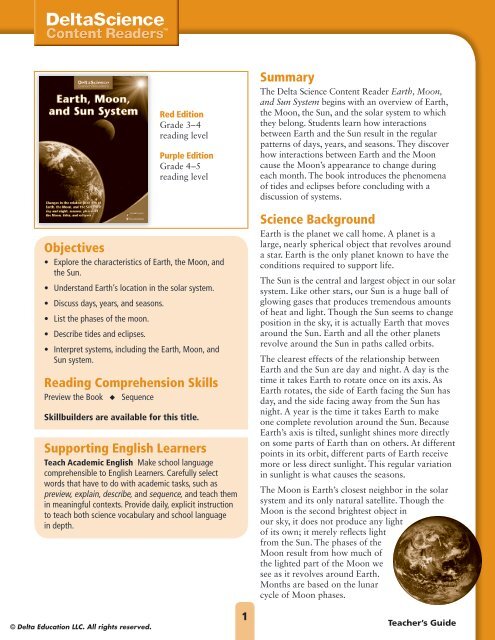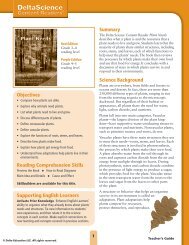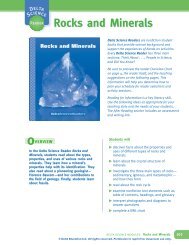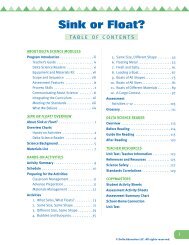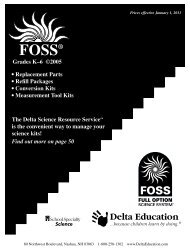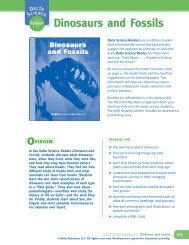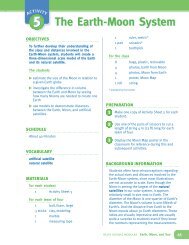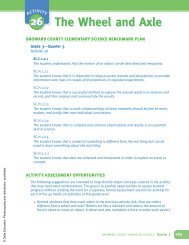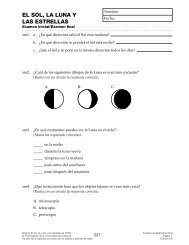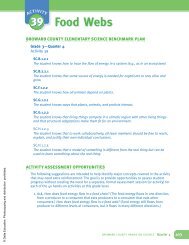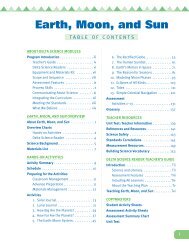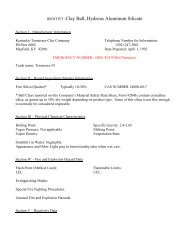Earth's Moon - Delta Education
Earth's Moon - Delta Education
Earth's Moon - Delta Education
You also want an ePaper? Increase the reach of your titles
YUMPU automatically turns print PDFs into web optimized ePapers that Google loves.
<strong>Delta</strong>Science<br />
Content Readers<br />
TM<br />
Red Edition<br />
Grade 3–4<br />
reading level<br />
Purple Edition<br />
Grade 4–5<br />
reading level<br />
Objectives<br />
• Explore the characteristics of Earth, the <strong>Moon</strong>, and<br />
the Sun.<br />
• Understand Earth’s location in the solar system.<br />
• Discuss days, years, and seasons.<br />
• List the phases of the moon.<br />
• Describe tides and eclipses.<br />
• Interpret systems, including the Earth, <strong>Moon</strong>, and<br />
Sun system.<br />
Reading Comprehension Skills<br />
Preview the Book ◆ Sequence<br />
Skillbuilders are available for this title.<br />
Supporting English Learners<br />
Teach Academic English Make school language<br />
comprehensible to English Learners. Carefully select<br />
words that have to do with academic tasks, such as<br />
preview, explain, describe, and sequence, and teach them<br />
in meaningful contexts. Provide daily, explicit instruction<br />
to teach both science vocabulary and school language<br />
in depth.<br />
© <strong>Delta</strong> <strong>Education</strong> LLC. All rights reserved.<br />
1<br />
Summary<br />
The <strong>Delta</strong> Science Content Reader Earth, <strong>Moon</strong>,<br />
and Sun System begins with an overview of Earth,<br />
the <strong>Moon</strong>, the Sun, and the solar system to which<br />
they belong. Students learn how interactions<br />
between Earth and the Sun result in the regular<br />
patterns of days, years, and seasons. They discover<br />
how interactions between Earth and the <strong>Moon</strong><br />
cause the <strong>Moon</strong>’s appearance to change during<br />
each month. The book introduces the phenomena<br />
of tides and eclipses before concluding with a<br />
discussion of systems.<br />
Science Background<br />
Earth is the planet we call home. A planet is a<br />
large, nearly spherical object that revolves around<br />
a star. Earth is the only planet known to have the<br />
conditions required to support life.<br />
The Sun is the central and largest object in our solar<br />
system. Like other stars, our Sun is a huge ball of<br />
glowing gases that produces tremendous amounts<br />
of heat and light. Though the Sun seems to change<br />
position in the sky, it is actually Earth that moves<br />
around the Sun. Earth and all the other planets<br />
revolve around the Sun in paths called orbits.<br />
The clearest effects of the relationship between<br />
Earth and the Sun are day and night. A day is the<br />
time it takes Earth to rotate once on its axis. As<br />
Earth rotates, the side of Earth facing the Sun has<br />
day, and the side facing away from the Sun has<br />
night. A year is the time it takes Earth to make<br />
one complete revolution around the Sun. Because<br />
Earth’s axis is tilted, sunlight shines more directly<br />
on some parts of Earth than on others. At different<br />
points in its orbit, different parts of Earth receive<br />
more or less direct sunlight. This regular variation<br />
in sunlight is what causes the seasons.<br />
The <strong>Moon</strong> is Earth’s closest neighbor in the solar<br />
system and its only natural satellite. Though the<br />
<strong>Moon</strong> is the second brightest object in<br />
our sky, it does not produce any light<br />
of its own; it merely reflects light<br />
from the Sun. The phases of the<br />
<strong>Moon</strong> result from how much of<br />
the lighted part of the <strong>Moon</strong> we<br />
see as it revolves around Earth.<br />
Months are based on the lunar<br />
cycle of <strong>Moon</strong> phases.<br />
Teacher’s Guide
What Are Earth, the<br />
<strong>Moon</strong>, and the Sun?<br />
(pages 2–11)<br />
Before Reading<br />
Discuss the Cover<br />
Cover Image Discuss the image on the cover of<br />
Earth, <strong>Moon</strong>, and Sun System. Use the information<br />
on the inside front cover to support the discussion.<br />
Science Statement Discuss the science statement.<br />
Help students understand “relative positions” by<br />
describing their positions relative to one another.<br />
Build Reading Skills (page 2)<br />
Preview the Book Use Build Reading Skills on<br />
page 2 to review how to preview the book. Discuss<br />
the steps. Then model previewing the headings.<br />
Think Aloud What can I learn from the headings?<br />
On page 14, I see the red heading “Earth and<br />
the Sun.” This must be the main topic. The next<br />
three headings, on pages 14–16, are smaller and<br />
blue. These headings must break down ideas about<br />
Earth and the Sun into smaller parts.<br />
Guide students as they finish previewing Earth,<br />
<strong>Moon</strong>, and Sun System. Focus on nonfiction<br />
text features.<br />
• Prompt them to look at the headings, photographs,<br />
captions, and diagrams. Ask questions such as<br />
Why do you think that feature is there? How will<br />
it help you understand what you read?<br />
• Prompt them to look at the bold Vocabulary<br />
words. Guide the class in looking up a<br />
Vocabulary word in the Glossary.<br />
Students can apply the skill in the Reflect on<br />
Reading activity on page 11.<br />
K-W-L Chart Have students begin a K-W-L chart.<br />
They should add to it after each section.<br />
What I Know<br />
The <strong>Moon</strong><br />
seems to<br />
change shape.<br />
What I Want<br />
to Learn<br />
Does the<br />
<strong>Moon</strong> really<br />
change shape?<br />
What I<br />
Learned<br />
Make a Connection (page 3)<br />
Make a Connection Discuss the Make a Connection<br />
question. Use this discussion to build background<br />
and activate prior knowledge about Earth, the<br />
<strong>Moon</strong>, and the Sun. (Possible answers: <strong>Moon</strong>: moves<br />
around Earth, looks as if changes shape, has craters,<br />
people have traveled there; Sun: huge, very hot and<br />
bright, rises in east and sets in west, plants need its<br />
light to grow)<br />
Find Out About Read each statement to help<br />
students set a reading purpose. Explain that these<br />
are the important topics that they will learn about<br />
in this section.<br />
Vocabulary Read the Vocabulary words aloud.<br />
Explain to students that they will see these words<br />
in bold in this section. Start a T-chart on the board<br />
for the Sun and the <strong>Moon</strong>. Have students add<br />
information to the chart as they read.<br />
During Reading<br />
Earth (page 4)<br />
• Reinforce the meanings of revolve and rotate.<br />
Have a student walk in a circle around you. Point<br />
out that the student is moving in a path around<br />
you the way Earth revolves around the Sun. Then<br />
have a student slowly spin in place to demonstrate<br />
how Earth rotates. Explain that revolution and<br />
rotation are the noun forms of the verbs revolve<br />
and rotate. We say Earth has completed one<br />
revolution when it has revolved around the Sun<br />
once. We say it has completed one rotation when<br />
it has rotated once. Challenge students to act<br />
out revolving and rotating at the same time to<br />
illustrate how Earth moves through space.<br />
• Discuss the photograph of Earth on page 5.<br />
Ask: What is the atmosphere? (a layer of gases<br />
around Earth)<br />
• Emphasize that Earth’s distance from the Sun<br />
is a key factor in Earth having liquid water, a<br />
requirement for living things. Earth receives<br />
energy from the Sun. Earth’s distance from the<br />
Sun means that it receives enough energy for<br />
water to be liquid instead of frozen ice, but not so<br />
much energy that liquids and gases “boil away”<br />
into space.<br />
<strong>Delta</strong> Science Content Readers<br />
2<br />
© <strong>Delta</strong> <strong>Education</strong> LLC. All rights reserved.
✔ Checkpoint (page 5) (atmosphere has gases, such<br />
as oxygen, that living things need; stays at<br />
temperatures that support life; has water in liquid<br />
form, and living things need water)<br />
Earth’s <strong>Moon</strong> (page 6)<br />
• Discuss the photograph of the <strong>Moon</strong> in the sky<br />
on page 6. Ask: What would happen to the light<br />
from the <strong>Moon</strong> if the Sun were gone? Explain.<br />
(There would be no more light, because the <strong>Moon</strong><br />
does not make its own light. We see the <strong>Moon</strong><br />
because light from the Sun reflects off the <strong>Moon</strong>.)<br />
• The <strong>Moon</strong>’s almost nonexistent atmosphere is<br />
responsible for many of its differences with Earth.<br />
There is no sound on the <strong>Moon</strong>, because there is<br />
no air to carry sound waves. There is no weather,<br />
because weather is the condition of the atmosphere.<br />
Because it has little atmosphere to protect<br />
it, meteorites do not slow down or burn up the<br />
way they do in Earth’s atmosphere, leading the<br />
<strong>Moon</strong>’s surface to be covered with craters.<br />
✔ Checkpoint (page 7) (has no liquid water and<br />
almost no atmosphere, gets much hotter and<br />
much colder, has many more craters)<br />
The Sun (page 8)<br />
• Ask: How is the Sun’s energy made? (Inside the<br />
Sun, hydrogen is changed to helium. This gives off<br />
huge amounts of energy.)<br />
• Ask: How do living things depend on the Sun’s<br />
energy for food? (Plants use light energy from<br />
the Sun, along with air and water, to make their<br />
own food. Energy in that food passes to animals<br />
that eat plants.)<br />
• Discuss the photograph of the Sun on page 9.<br />
Explain that this photograph was taken with a<br />
special telescope used to study the Sun. Emphasize<br />
that people should never look directly at the Sun.<br />
• Help students understand how energy from the<br />
Sun powers the water cycle. Ask: What happens<br />
to a puddle on a hot day? (Possible answer: It<br />
dries up.) Explain that energy from the Sun heats<br />
up the water in the puddle, causing it to change<br />
from liquid water to the gas water vapor. As part<br />
of the water cycle, this water may eventually<br />
come back to Earth’s surface as rain or snow.<br />
✔ Checkpoint (page 9) (The Sun is a star. It is made<br />
mostly of the gases hydrogen and helium.)<br />
The Solar System (page 10)<br />
• Point out the phrase “not to scale” in the picture<br />
of the solar system on page 10. Explain that this<br />
means that the sizes of the objects and the distances<br />
between them are not what they would be if you<br />
shrunk the solar system down to the size of this<br />
picture. Because the sizes of objects in the solar<br />
system vary so greatly and the distances between<br />
them are so vast, it would be impossible to make<br />
a picture of the solar system of this size to scale.<br />
• From the time it was discovered in 1930 until<br />
2006, Pluto was considered a planet, even though<br />
it was unlike other planets in many ways. In 2006<br />
Pluto was reclassified as a dwarf planet. Two<br />
other planet-like space objects were given dwarf<br />
planet status at the same time: Ceres, the largest<br />
object orbiting in the asteroid belt, and Eris,<br />
discovered in 2003 orbiting beyond Neptune.<br />
• Ask: What is gravity? (the force that pulls all<br />
objects toward one another) Why is this force<br />
important to the solar system? (Objects stay in<br />
their orbits because of gravity.)<br />
✔ Checkpoint (page 11) (Possible answers: Sun:<br />
at center of solar system, largest object; Inner<br />
planets: small and dense, solid and rocky surfaces,<br />
have few or no moons; Outer planets: very cold,<br />
huge, have rings and many moons, made mostly<br />
of gas; Comets: made of frozen gases, ice, rock,<br />
and dust; Asteroids: made of rock, metal, or both)<br />
After Reading<br />
Reflect on Reading (page 11) (Possible answer:<br />
The picture on page 6 helped me understand what<br />
craters look like.) After students complete the<br />
activity, have them describe the picture they chose<br />
to a partner, using their own words.<br />
Apply Science Concepts (page 11) This activity<br />
applies a concept from Find Out About on page 3.<br />
Encourage students to review the information about<br />
the <strong>Moon</strong> on pages 6–7 before answering. (Possible<br />
answer: I would need a spacesuit with air, because<br />
the <strong>Moon</strong> has almost no atmosphere. The spacesuit<br />
would also have to protect me from the <strong>Moon</strong>’s<br />
temperatures, which can get much hotter and much<br />
colder than Earth’s.)<br />
© <strong>Delta</strong> <strong>Education</strong> LLC. All rights reserved.<br />
3 Earth, <strong>Moon</strong>, and Sun System
How Do Earth, the<br />
<strong>Moon</strong>, and the Sun<br />
Interact? (pages 12–23)<br />
Before Reading<br />
Build Reading Skills (page 12)<br />
Sequence Use Build Reading Skills on page 12<br />
to review sequence. Discuss the tips. Then model<br />
identifying the sequence of seasons in the Northern<br />
Hemisphere in the diagram on page 16.<br />
Think Aloud Earth has four seasons. Spring is one<br />
season. Which season happens next? I’ll follow<br />
the arrows to find out. Summer is the next<br />
season. Fall is the season after that. Winter is<br />
the last season before we have spring again.<br />
Guide students as they identify other familiar<br />
sequences, such as the things they do to get ready<br />
for school every morning or the steps they have<br />
followed in a recipe. Students can apply the skill in<br />
the Reflect on Reading activity on page 23.<br />
Make a Connection (page 13)<br />
Make a Connection Discuss the Make a Connection<br />
question. Use this discussion to build background<br />
and activate prior knowledge about how Earth,<br />
the <strong>Moon</strong>, and the Sun interact. (Possible answer:<br />
Maybe the Sun seems to move across the sky because<br />
Earth rotates.)<br />
Find Out About Read each statement to help<br />
students set a reading purpose. Explain that these<br />
are the important topics that they will learn about<br />
in this section.<br />
Vocabulary Read the Vocabulary words aloud.<br />
Explain to students that they will see these words<br />
in bold in this section. Start a word web on the<br />
board with Systems in the center. Add Earth and<br />
Sun System and Earth, <strong>Moon</strong>, and Sun System in<br />
two connected circles. Have students add words and<br />
information to the web as they read.<br />
During Reading<br />
Earth and the Sun (page 14)<br />
• You may wish to use a classroom globe to<br />
demonstrate how Earth rotates around an axis.<br />
You can extend the demonstration by shining a<br />
flashlight on the globe while it spins to illustrate<br />
the cause of day and night.<br />
• Emphasize that the word day has a special<br />
meaning when used to describe the movement<br />
of the planets. Ask: What is a day? (the amount<br />
of time a planet takes to rotate once) How long<br />
is a day on Earth? (about 24 hours) Discuss that<br />
other planets rotate at different speeds, so their<br />
days are different lengths.<br />
• Ask: What changes can we see in the sky every<br />
day because of Earth’s rotation? (The Sun, <strong>Moon</strong>,<br />
and stars seem to rise in the east. Then they seem<br />
to move slowly across the sky and set in the west.)<br />
• Ask: What is a year? (the amount of time a<br />
planet takes to revolve once around the Sun)<br />
• Discuss the diagram of a year on page 15.<br />
Ask: What does the arrow in the picture<br />
show? (Earth’s orbit) Do you think a planet with<br />
a larger orbit than Earth’s would have a longer or<br />
shorter year? Explain. (longer, because it would<br />
take longer to revolve once around the Sun)<br />
• The cause of the seasons is one of the most<br />
commonly misunderstood science concepts.<br />
Because we are familiar with feeling warmer<br />
when closer to a source of heat, it is easy to<br />
conclude that warmer months occur when<br />
Earth is closer to the Sun. But in fact, Earth is<br />
usually closest to the Sun early in January, when<br />
the Northern Hemisphere has winter. It is usually<br />
farthest from the Sun early in July, when the<br />
Northern Hemisphere has summer.<br />
• Ask: What is the Northern Hemisphere like in<br />
summer? (The Sun appears higher in the sky.<br />
There are more hours of daylight. Temperatures<br />
are warmer.)<br />
• Direct sunlight warms Earth more than indirect<br />
sunlight because energy from rays of direct<br />
sunlight is concentrated in a smaller area. This<br />
warms the area more than the more spread out<br />
rays of indirect sunlight would. Along with the<br />
increased number of daylight hours, this is what<br />
causes summer to be warmer than winter.<br />
<strong>Delta</strong> Science Content Readers<br />
4<br />
© <strong>Delta</strong> <strong>Education</strong> LLC. All rights reserved.
• Discuss equinoxes. On two days of the year,<br />
called equinoxes, the number of hours of daylight<br />
and darkness are equal. On these days, we<br />
experience about 12 hours of daylight and 12<br />
hours of darkness. In the Northern Hemisphere,<br />
the spring equinox occurs on March 20 or 21<br />
and marks the beginning of spring. The autumn<br />
equinox occurs on September 22 or 23 and marks<br />
the beginning of fall.<br />
✔ Checkpoint (page 17) (Earth has seasons because<br />
its axis is tilted. As Earth revolves around the Sun,<br />
this tilt causes parts of Earth to point more toward<br />
the Sun. Other parts of Earth point more away<br />
from the Sun.)<br />
Earth, the <strong>Moon</strong>, and the Sun (page 18)<br />
• Ask: What do we say the <strong>Moon</strong> is doing when<br />
we see more and more of its lighted side each<br />
night? (waxing, getting fuller) In which phase<br />
can we see the whole side of the <strong>Moon</strong> that is<br />
lighted? (full moon) What do we say the <strong>Moon</strong><br />
is doing after the full moon phase? (waning,<br />
getting smaller)<br />
• Help students connect the diagram of the lunar<br />
cycle on page 19 with the photographs of the<br />
phases of the <strong>Moon</strong> along the bottom of pages<br />
18 and 19. Ask: In the lunar cycle picture, how<br />
much of the <strong>Moon</strong> is lighted by the Sun in each<br />
phase? (half) Point to the phase at the bottom of<br />
the diagram. Which phase is this? (third quarter)<br />
What do we see during this phase? (We see half<br />
of the lighted side of the <strong>Moon</strong> and half of the<br />
dark side.)<br />
• Ask: Suppose you are on the beach one sunny<br />
day. You can see the <strong>Moon</strong> in the sky overhead.<br />
Do you think it is closer to high tide or low tide?<br />
Explain. (Possible answer: I think it is closer to<br />
high tide. The <strong>Moon</strong>’s pull on Earth is strongest on<br />
the side of Earth closest to the <strong>Moon</strong>. If the <strong>Moon</strong><br />
is in the sky overhead, the beach must be on the<br />
side of Earth closest to the <strong>Moon</strong>.)<br />
✔ Checkpoint (page 22) (As the <strong>Moon</strong> rotates,<br />
different parts face the Sun. The phases of the<br />
<strong>Moon</strong> happen because the <strong>Moon</strong> revolves around<br />
Earth. As the <strong>Moon</strong> moves in its orbit, we see<br />
more or less of the side of the <strong>Moon</strong> that is<br />
lighted by the Sun.)<br />
About Systems (page 23)<br />
• Encourage students to think of other systems<br />
they know about, such as school systems.<br />
Ask: What are some parts of a school system?<br />
(Possible answers: school buildings, teachers,<br />
students, principals) What are some other systems<br />
you know about? (Possible answers: human<br />
digestive system, transportation systems)<br />
• Ask: Do you think the solar system would still<br />
be a system without gravity? Explain. (Possible<br />
answer: No. Objects in the solar system interact<br />
because of gravity. Without gravity, the Sun,<br />
planets, and other objects would not affect one<br />
another, so they would not be a system. They<br />
would go off in separate directions.)<br />
✔ Checkpoint (page 23) (A system is a group of<br />
related parts that form a whole. The parts affect<br />
one another, or interact. Possible answers: solar<br />
system; Earth and the Sun; Earth, the <strong>Moon</strong>,<br />
and the Sun)<br />
After Reading<br />
Reflect on Reading (page 23) Encourage students<br />
to refer to the photographs on pages 18–19 when<br />
making their moon phase cards. (Sequence of<br />
phases: new moon, waxing crescent, first quarter,<br />
waxing gibbous, full moon, waning gibbous, third<br />
quarter, waning crescent) You may wish to extend<br />
the activity by making it into a game. Have<br />
students take turns displaying a card, and have<br />
other students tell which phases come directly<br />
before and after that one.<br />
Apply Science Concepts (page 23) This activity<br />
applies a concept from Find Out About on page 13.<br />
NASA’s eclipse Web site is a good place to research<br />
upcoming eclipses. Note that lunar eclipses are<br />
more likely to be on the class list because they are<br />
visible from a much wider area on Earth than<br />
solar eclipses.<br />
➥<br />
Continued on last page<br />
© <strong>Delta</strong> <strong>Education</strong> LLC. All rights reserved.<br />
5 Earth, <strong>Moon</strong>, and Sun System
Name:<br />
Date:<br />
Test: Earth, <strong>Moon</strong>, and Sun System<br />
Part A: Vocabulary<br />
moon orbit phase revolve<br />
rotate solar system Sun tide<br />
Choose the correct vocabulary word for each sentence. Write the word on the line.<br />
1. Our _______________________ is a star, a huge ball of very hot, glowing gases.<br />
2. Both the inner planets and the outer planets _____________________________<br />
around the Sun.<br />
3. Earth and the other planets _____________________________________ around<br />
an imaginary center line called an axis.<br />
4. One rocky _____________________________________ moves around our planet.<br />
5. Our _____________________________________ has many objects, including<br />
planets, asteroids, and comets.<br />
6. Earth’s _____________________________ around the Sun is shaped like an oval.<br />
7. Each different shape of the <strong>Moon</strong> that we see is a different<br />
_____________________________________.<br />
8. The regular rise and fall of the water level in the ocean is called the<br />
_____________________________________.<br />
Part B: Science Concepts<br />
Mark the best answer to each question.<br />
9. Which of these is a main feature of the <strong>Moon</strong>’s surface?<br />
A sand<br />
C ice<br />
B craters<br />
D oceans<br />
Earth, <strong>Moon</strong>, and Sun System © 2010 <strong>Delta</strong> <strong>Education</strong> LLC Permission granted to purchaser to photocopy for classroom use.<br />
10. How much time does it take for Earth to spin once around its axis?<br />
A a day<br />
B a week<br />
C a month<br />
D a year<br />
<strong>Delta</strong> Science Content Readers
Test: Earth, <strong>Moon</strong>, and Sun System (continued)<br />
11. What is a main cause of high tide?<br />
A energy from the Sun<br />
C the <strong>Moon</strong>’s pull on Earth<br />
Permission granted to purchaser to photocopy for classroom use.<br />
B the <strong>Moon</strong>’s rotation<br />
D strong ocean currents<br />
12. What causes most of the interactions in the Earth, <strong>Moon</strong>, and Sun system?<br />
A energy<br />
C gas<br />
B gravity<br />
D tides<br />
Write the answer.<br />
13. Think about a planet whose atmosphere has no oxygen. The planet is cold<br />
because it is far from the Sun. It has ice, but no liquid water. Could this<br />
planet support life the way Earth can? Explain.<br />
Earth, <strong>Moon</strong>, and Sun System © 2010 <strong>Delta</strong> <strong>Education</strong> LLC<br />
14. Look at the picture. Label what season it would be in the Northern<br />
Hemisphere at points A and B. Tell which season is warmer and why.<br />
A<br />
equator<br />
A<br />
Sun<br />
B<br />
15. Describe what causes the phases of the <strong>Moon</strong>.<br />
direct rays of sunlight<br />
B<br />
Earth, <strong>Moon</strong>, and Sun System
Let’s Review<br />
(inside back cover)<br />
Have students complete their K-W-L charts before answering<br />
these questions. Possible answers are shown.<br />
1. Cover Connection (As Earth rotates, the part of<br />
the planet that faces the Sun has daylight. The part<br />
that is turned away from the Sun has darkness, or<br />
night. Earth has seasons because its axis is tilted.<br />
As Earth revolves around the Sun, this tilt causes<br />
parts of Earth to point more toward the Sun and<br />
other parts to point more away from the Sun.<br />
Tides are caused mainly by gravity between Earth<br />
and the <strong>Moon</strong>. As Earth rotates, different places<br />
on Earth have high tide and low tide.)<br />
2. (The <strong>Moon</strong> has no liquid water and almost no<br />
atmosphere. It gets much hotter and much colder<br />
than Earth. It has many craters. The <strong>Moon</strong> revolves<br />
around Earth. It also rotates. It takes the same<br />
amount of time to rotate once as to revolve once.)<br />
3. (As Earth rotates, the part of the planet that faces<br />
the Sun has day. The part that is turned away<br />
from the Sun has night.)<br />
4. Sequence (The seasons always happen in the<br />
same order because Earth always stays tilted in<br />
the same direction and it always revolves around<br />
the Sun in the same direction.)<br />
5. Write (Descriptions will vary but should include<br />
information about the weather and the amount<br />
of daylight and darkness during the chosen season.<br />
Students should also include their reasoning about<br />
how they think the Sun’s rays hit their part of<br />
Earth during that season.)<br />
Try It! An area with a flat, level surface and a clear<br />
view toward the south works best for observing<br />
shadows. Remind students to mark where their feet<br />
are so they can stand in the same place later in the<br />
day. Encourage them to trace the whole shadow<br />
each time. The marks should illustrate how students’<br />
shadows change in both position and length over<br />
the course of a day.<br />
Science at Home Have students do this activity<br />
at home with a family member. Weather and the<br />
timing of moonrise and moonset will prevent<br />
students from making observations every night,<br />
but attempting to do so will provide the most<br />
complete record of the lunar cycle. A park or other<br />
area with few artificial lights will provide the best<br />
conditions for observing the <strong>Moon</strong>.<br />
Answers to Test<br />
(Teacher’s Guide pages 6–7)<br />
1. Sun 2. revolve 3. rotate 4. moon 5. solar system 6. orbit 7. phase<br />
8. tide 9. B 10. A 11. C 12. B 13. No. Living things need oxygen,<br />
and this planet does not have any. Living things need the right<br />
temperatures, and this planet is cold and far from the Sun.<br />
Living things also need liquid water, and this planet has only ice.<br />
14. A: summer; B: winter; Summer is warmer because the<br />
Northern Hemisphere is tilted toward the Sun, so the sun’s rays hit<br />
it more directly. 15. The phases of the <strong>Moon</strong> happen because the<br />
<strong>Moon</strong> revolves around Earth. As the <strong>Moon</strong> moves in its orbit, we<br />
see more or less of the side of the <strong>Moon</strong> that is lighted by the Sun.<br />
Additional Assessment Opportunities Use the<br />
Checkpoints, Reflect on Reading, and Apply Science<br />
Concepts features and Let’s Review questions as<br />
additional assessment opportunities.<br />
<strong>Delta</strong> Science Content Readers are 24-page nonfiction student books with informative, engaging<br />
text and full-color photos and illustrations. The readers present key science content and vocabulary<br />
found on state tests, present key reading skills and strategies useful for reading informational text,<br />
support and extend the experiences and content of hands-on activities, promote scientific inquiry,<br />
and serve as a home-school link. They are available in two editions: Red Edition for Grades 3–4 and<br />
Purple Edition for Grades 4–5.<br />
Copyright © 2010 <strong>Delta</strong> <strong>Education</strong> LLC,<br />
a member of the School Specialty Family.<br />
All rights reserved.<br />
This teacher’s guide is available online at<br />
www.deltaeducation.com<br />
1-800-442-5444<br />
Earth, <strong>Moon</strong>, and Sun<br />
System<br />
Teacher’s Guide<br />
1278156<br />
ISBN: 978-1-60395-457-0<br />
9 0 0 0 0 ><br />
9 781603 954570<br />
8<br />
Printing 1—10/2009<br />
Quebecor World, Leominster, MA<br />
© <strong>Delta</strong> <strong>Education</strong> LLC. All rights reserved.


